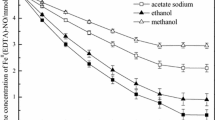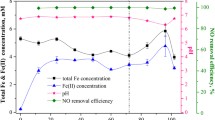Abstract
A promising chemical absorption–biological reduction integrated process has been proposed. A major problem of the process is oxidation of the active absorbent, ferrous ethylenediaminetetraacetate (Fe(II)EDTA), to the ferric species, leading to a significant decrease in NO removal efficiency. Thus the biological reduction of Fe(III)EDTA is vitally important for the continuous NO removal. Oxygen, an oxidizing agent and biological inhibitor, is typically present in the flue gas. It can significantly retard the application of the integrated process. This study investigated the influence mechanism of oxygen on the regeneration of Fe(II)EDTA in order to provide insight on how to eliminate or decrease the oxygen influence. The experimental results revealed that the dissolved oxygen and Fe(III)EDTA simultaneously served as electron acceptor for the microorganism. The Fe(III)EDTA reduction activity were directly inhibited by the dissolved oxygen. When the bioreactor was supplied with 3% and 8% oxygen in the gas phase, the concentration of initial dissolved oxygen in the liquid phase was 0.28 and 0.68 mg l−1. Correspondingly, the instinct Fe(III)EDTA reduction activity of the microorganism determined under anoxic condition in a rotation shaker decreased from 1.09 to 0.84 and 0.49 mM h−1. The oxidation of Fe(II)EDTA with dissolved oxygen prevented more dissolved oxygen access to the microorganism and eased the inhibition of dissolved oxygen on the microorganisms.





Similar content being viewed by others
References
Arnold RG, Hoffmann MR, DiChristina TJ, Picardal FW (1990) Regulation of dissimilatory Fe(III) reduction activity in Shewanella putrefaciens. Appl Environ Microbiol 56:2811–2817
Chen JM, Ma JF (2006) Abiotic and biological mechanisms of nitric oxide removal from waste air in biotrickling filters. J Air Waste Manage Assoc 56(1):32–36
Cooper DC, Picardal FW, Schimmelmann A, Coby AJ (2003) Chemical and biological interactions during nitrate and goethite reduction by Shewanella putrefaciens 200. Appl Environ Microbiol 69:3517–3525
Coves J, Fontecave M (1993) Reduction and mobilization of iron by a NAD(P)H: flavin oxidoreductase from Escherichia coli. Eur J Biochem 211:635–641
DiChristina TJ (1992) Effects of nitrate and nitrite on dissimilatory iron reduction by Shewanella putrefaciens 200. J Bacteriol 174:1891–1896
Dilmore R, Neufeld RD, Hammack RW (2006) Laboratory-scale iron EDTA-Based NO x scrubbing process with biological treatment and regeneration of spent scrubber water. Environ Eng Sci 23:788–802
Feinberg LF, Holden JF (2006) Characterization of dissimilatory Fe(III) versus NO −3 reduction in the hyperthermophilic archaeon Pyrobaculum aerophilum. J Bacteriol 188:525–531
Fontecave M, Coves J, Pierre JL (1994) Ferric reductases or flavin reductases? Biometals 7:3–8
Gao X, Du Z, Ding HL, Wu ZL, Lu H, Luo ZY, Cen KF (2010a) Kinetics of NO x absorption into (NH4)2SO3 solution in an ammonia-based wet flue gas desulfurization process. Energ Fuel 24:5876–5882
Gao X, Jiang Y, Fu YC, Zhong Y, Luo ZY, Cen KF (2010b) Preparation and characterization of CeO2/TiO2 catalysts for selective catalytic reduction of NO with NH3. Catal Commun 11:465–469
Gao L, Mi XH, Zhou Y, Li W (2011) A pliot study on the regeneration of ferrous chelate complex in NO x scrubber solution by a biofilm electrode reactor. Bioresour Technol 102:2605–2609
Harvey AE Jr, Smart JA, Amis ES (1955) Simultaneous spectrophotometric determination of iron (II) and total iron with 1,10-phenanthroline. Anal Chem 27:26–29
Imlay JA (2008) Cellular defenses against superoxide and hydrogen peroxide. Annu Rev Biochem 77:755–776
Johnson DB, McGinness S (1991) Ferric iron reduction by acidophilic heterotrophic bacteria. Appl Environ Microbiol 57:207–211
Koppenol WH, Stanbury DM, Bounds PL (2010) Electrode potentials of partially reduced oxygen species, from dioxygen to water. Free Radical Biol Med 49:317–322
Kusel K, Roth U, Drake HL (2002) Microbial reduction of Fe(III) in the presence of oxygen under low pH conditions. Environ Microbiol 4:414–421
Li W, Wu CZ, Shi Y (2006) Metal chelate absorption coupled with microbial reduction for the removal of NOx from flue gas. J Chem Technol Biotechnol 81:306–311
Li W, Wu CZ, Zhang SH, Shao K, Shi Y (2007) Evaluation of microbial reduction of Fe(III)EDTA in a chemical absorption–biological reduction integrated NO x removal system. Environ Sci Technol 41:639–644
Mi XH, Gao L, Zhang SH, Cai LL, Li W (2009) A new approach for Fe(III)EDTAreduction in NOx scrubber solution using bio-electro reactor. Bioresour Technol 100:2940–2944
Niu HJY, Leung DYC (2010) A review on the removal of nitrogen oxides from polluted flow by bioreactors. Environ Rev 18:175–189
Obuekwe CO, Westlake DWS (1981) Effect of nitrate on reduction of ferric iron by a bacterium isolated from crude oil. Can J Microbiol 27:692–697
Obuekwe CO, Westlake DWS (1982) Effect of reducible compounds (potential electron acceptors) on reduction of ferric iron by Pseudomonas species. Microbiol Lett 19:57–62
Ogden JE, Moore PK (1995) Inhibition of nitric-oxide synthase potential for a novel class of therapeutic agent. Trends Microbiol 13:70–78
Pierre JL, Fontecave M, Crichton RR (2002) Chemistry for an essential biological process: the reduction of ferric iron. Biometals 15:341–346
Schroder I, Johnson E, de Vries S (2003) Microbial ferric iron reductases. FEMS Microbiol Rev 27:427–447
Shi Y, Littlejohn D, Chang SG (1996) Integrated tests for removal of nitric oxide with iron thiochelate in wet flue gas desulfurization systems. Environ Sci Technol 30(11):3371–3376
Solomon S, Portmann RW, Sanders RW, Daniel JS, Madsen W, Bartram B, Dutton EG (1999) On the role of nitrogen dioxide in the absorption of solar radiation. J Geophys Res 104:12047–12058
Straub KL, Benz M, Schink B (2001) Iron metabolism in anoxic environments at near neutral pH. FEMS Microbiol Ecol 34:181–186
van der Maas P, van de Sandt T, Klapwijk B, Lens P (2003) Biological reduction of nitric oxide in aqueous Fe(II)EDTA solutions. Biotechnol Prog 19:1323–1328
van der Maas P, van den Bosch P, Klapwijk B, Lens P (2005) NO x removal from flue gas by an integrated physicochemical absorption and biological denitrification process. Biotechnol Bioeng 90:433–441
Volz A, Kley D (1988) Evaluation of the Montsouris series of ozone measurements made in the nineteenth century. Nature 332:240–242
Zhang SH, Li W, Wu CZ, Chen H, Shi Y (2007) Reduction of Fe(II)EDTA-NO by a newly isolated Pseudomonas sp. strain DN-2 in NO x scrubber solution. Appl Microbiol Biotechnol 76:1181–1187
Zhang SH, Cai LL, Mi XH, Jiang JL, Li W (2008a) NOx removal from simulated flue gas by chemical absorption–biological reduction integrated approach in a biofilter. Environ Sci Technol 42:3814–3820
Zhang SH, Mi XH, Cai LL, Jiang JL, Li W (2008b) Evaluation of complexed NO reduction mechanism in a chemical absorption–biological reduction integrated NO x removal system. Appl Microbiol Biotechnol 79(4):537–544
Acknowledgements
This work was sponsored by the National High Technology Research and Development Program of China (No. 2006AA06Z345), the National Natural Science Foundation of China (No. 20676120) and the Science and Technology Project of Zhejiang Province, China (No. 2006C23064).
Author information
Authors and Affiliations
Corresponding author
Rights and permissions
About this article
Cite this article
Zhang, SH., Shi, Y. & Li, W. Biological and chemical interaction of oxygen on the reduction of Fe(III)EDTA in a chemical absorption–biological reduction integrated NO x removal system. Appl Microbiol Biotechnol 93, 2653–2659 (2012). https://doi.org/10.1007/s00253-011-3573-z
Received:
Revised:
Accepted:
Published:
Issue Date:
DOI: https://doi.org/10.1007/s00253-011-3573-z




